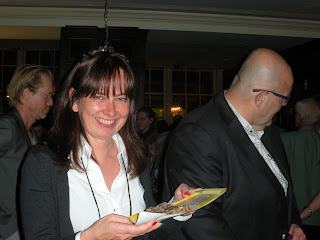I am exhausted this week. But it's not down to kids waking me up, or burning the midnight oil to finish a book, or illness, or anything else like that. It's entirely self-inflicted. Because on Tuesday and Wednesday night, despite knowing I would be woken at 7, I stayed up until 4 am and 5.30 am respectively.
To watch baseball.
(Sorry for bringing this up when it's so raw, Beth...)
Despite being a Limey, and a distaste for many other popular American pastimes - NFL, basketball, voting for swivel-eyed, right-wing retards - I love baseball. And in baseball I love The Boston Red Sox. I was taken to Fenway Park one gorgeous August day in 1980 to see the Sox beat the Brewers. I can't remember the score but I remember the sounds and the smells: the gasp of excitement and then the roar as Freddie Lynn homered, the scent of hot dogs and body odour of the fat man sat next to me, the sheer greenness of it all. This was before I'd even been to a cricket match. Cricket became, and still remains, my favourite sport, but I've always retained a fondness for baseball and the boys from Boston.
But I lived in the UK. So I would follow the scores in the newspaper, printed the day after the day after the game. Soon I realised the Boston Red Sox scores weren't worth following, but I still did. Channel Four over here showed a few games in the 1990s, and then Channel Five. I caught a few when I could and sometimes they showed the Sox. I read books written by a very gloomy man with big teeth which spoke about a 'Curse.' And when he visited, I asked my Bostonian uncle about the Red Sox and how they were doing and he would also curse.
One curse was lifted - my uncle still employs the vernacular - in 2004, which I remember fondly. I watched as many games as I could on TV, especially the remarkable comeback to vanquish the hated Yankees (I love New York and have been to it more times than Boston, but still, it's the bloody Yankees innit) and revelled and shared in the sheer wonderful euphoria of a town that I had only visited a few times, but whose ballpark was etched on my memory forever. (Speaking of which, Fenway is 100 years old next April. It was opened only a few days after Titanic sank. I'll leave the metaphors to the rest of you...)
I soon realised I could pay a meagre sum to the cash-strapped folk at the MLB and watch the Red Sox as many times as I wanted. I could watch them live on my PC, or the day after, or highlights. My baseball fandom grew, as did my love for The Sox and their gum-chewing, egg-headed (as in head shaped like an egg not clever, though he seems bright enough, though he may be gum-chewing elsewhere soon, sadly) coach Terry Francona. They won the whole show again in 2007 and I felt as if I had shared it with them. Seasons since have been less favourable but you can't argue with two World Series in the space of three years.
But every sports fans know you have to pay. That with the smooth comes plenty of rough. This is why we hate the Yankees, or Manchester United, or the Australian cricket team. Those people don't know what pain and loss is. All that never-ending success (except it does end, like it has with Australia and, please Lord, soon will NYY and MUFC). The average Red Sox fan above a certain age could sandpaper their house and the whole street with the rough they've experienced (I'll leave others to work out what fans of the Cubs could cover...). Another chapter of pain was written this week. I'd been watching the 'collapse' with some disbelief over the past few weeks, wondering how a team so good could become a team so bad. This isn't the place to share my theories, other than to say big-name players don't alway make big-game players, and characteristics like bottle and mettle don't always show up in people's averages and ERA (you hear me Theo?).
I watched in bleary-eyed disbelief as Tampa came within one strike of losing and won, and the Sox went from within one strike of winning and lost. And as the Sox lost, still hoping to make a one-game play-off, almost simultaneously the Rays hit a walk-off home run to go through and Boston were eliminated.
Part of me was crestfallen. The part that wanted my team to win, and that's a pretty big part. As my wife will tell you, I can be pretty moody for a few hours after Liverpool are defeated or England lose at cricket (I did think I'd grow out of that actually, as life and kids and other properly important stuff came along, but I haven't - if anything it's got worse). But at the same time I was flabbergasted and amazed and even invigorated by the capacity of sport to provide such unbelievable, unscripted drama. It reminded me why I spend so much time watching, reading about, writing and talking about these foolish games. The highs of the ALDS of 2004; the European Cup Final of 2005; the Ashes of 2005. Then there the lows, too painful to go over here, but the Red Sox collapse now goes alongside them. But without them the highs wouldn't mean so much. 'You gotta lose a coupla fights to know what it's like to win,' Frank Sinatra once said, and he was right (he wasn't a Cubs fan either...)
The title of this blog is a misquote of a famous comment made by the hated manager of the hated Manchester United, Sir Alex Ferguson, a charmless man but a wonderful manager. His team had just won the European Cup against Bayern Munich by scoring two goals in the injury time. 'Football,' he said afterwards, when he was how he felt. 'Bloody hell.'
It means nothing, but everyone who follows sport knew what he meant. It carries all manner of meaning depending on how you say it. It can be said in triumph or in disgust. Everybody fan has their '
cheers
Dan - Friday
*except one of the Tampa fans. I've heard they divorced and he got the cowbell.
























































